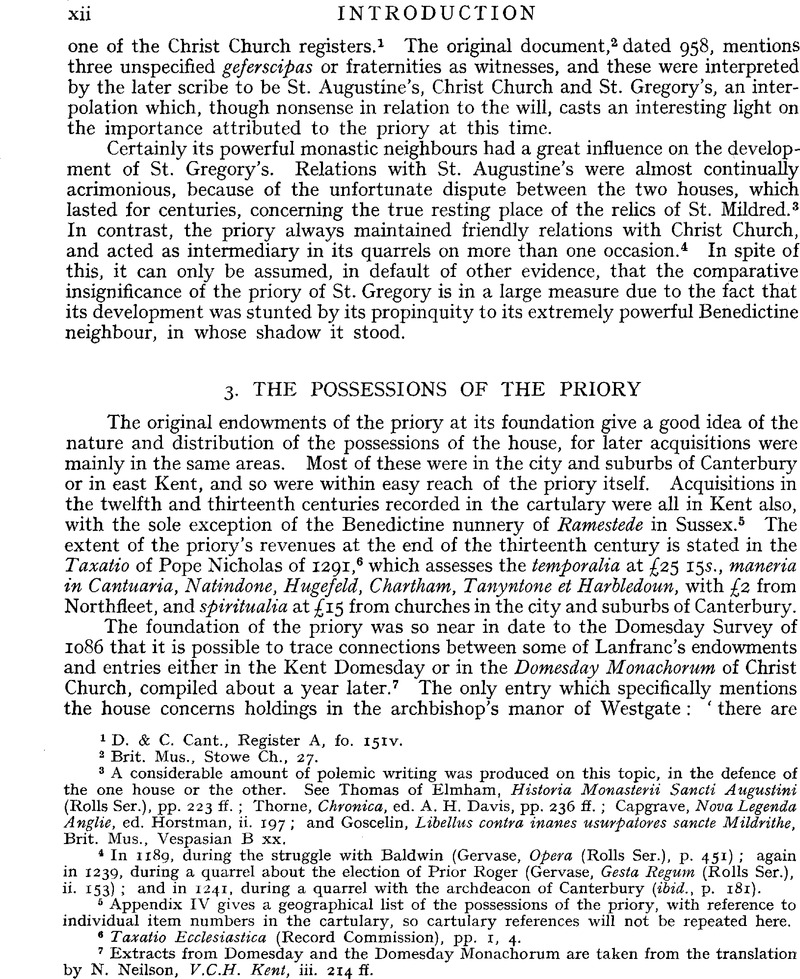No CrossRef data available.
Article contents
3. The Possessions of the Priory
Published online by Cambridge University Press: 24 December 2009
Abstract

- Type
- Introduction
- Information
- Copyright
- Copyright © Royal Historical Society 1956
References
page xii note 5 Appendix IV gives a geographical list of the possessions of the priory, with reference to individual item numbers in the cartulary, so cartulary references will not be repeated here.
page xii note 6 Taxatio Ecclesiastica (Record Commission), pp. 1, 4.
page xii note 7 Extracts from Domesday and the Domesday Monachorum are taken from the translation by N. Neilson, V.C.H. Kent, iii. 214 ff.
page xiii note 1 This is probably the mill called Crienemelne in the confirmation by Archbishop Theobald.
page xiii note 2 A general papal licence to appropriate its churches was given to the priory towards the end of the twelfth century (1188?) ; see cartulary no. 22.
page xiv note 1 See Cal. Charter Rolls, ii. 300 and v. 197, for the genealogy of this family in connection with Leeds priory.
page xiv note 2 The tithes of Waltham are described in archiepiscopal confirmations as tarn militum quam rusticorum.
page xiv note 3 Domesday Monachorum, V.C.H. Kent, iii. 235.
page xiv note 4 Book of Fees, p. 1346 and p. 1381.
page xiv note 5 Abbreviatio Placitorum (Record Commission), p. 39b, and Bracton's Notebook, ed. F. W. Maitland, no. 704.
page xv note 1 Hasted, History of Kent, iii. 240.
page xv note 2 This supports the theory that the denns in the weald were used as pasture for animals from more distant parts of Kent. See Cartulary of Bilsington Priory, ed. N. Neilson, pp. 22–3.
page xv note 3 The statement in Dugdale's Monasticon (iv. 658) that the nuns were re-established and their possessions confirmed to them by Archbishop Boniface appears to be an error. A transcript of this confirmation, giving the archbishop's name as Boniface, is given in Bodl. Tanner MS. 223, fo. 52V., but in Lambeth MS. 1212, a more reliable version of the same Register, the initial B. only is given, with a marginal identification as Baldwin, which the names of the witnesses corroborate. In this case the confirmation was made before the dissolution of the house and there is no evidence of its re-foundation.
page xv note 4 A Harrow court roll of 1513 (transcript supplied by Mr. Percy Davenport, from a document in his possession) states, among complaints about the decayed condition of Bentley, that it had been founded by an archbishop of Canterbury who had given it to St. Gregory' priory, and ‘ time out of mind in the immemorial past’, a canon of the priory had served Bentley.
page xv note 5 Matthew Paris, Chronica Majora (Rolls Ser.), v. 33.
page xvi note 1 Hasted, History of Kent, xii. 142; and P.C.C. Wills, Adderley, fo. 367.




